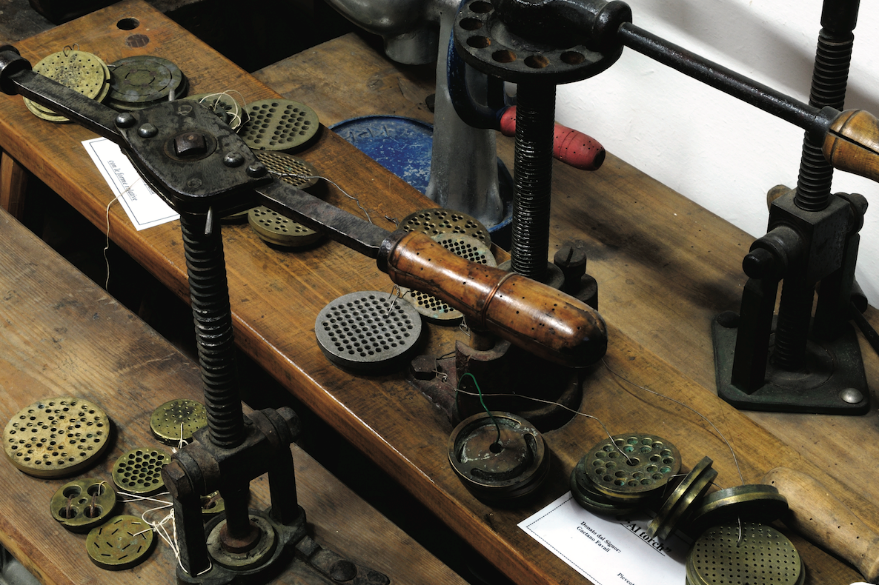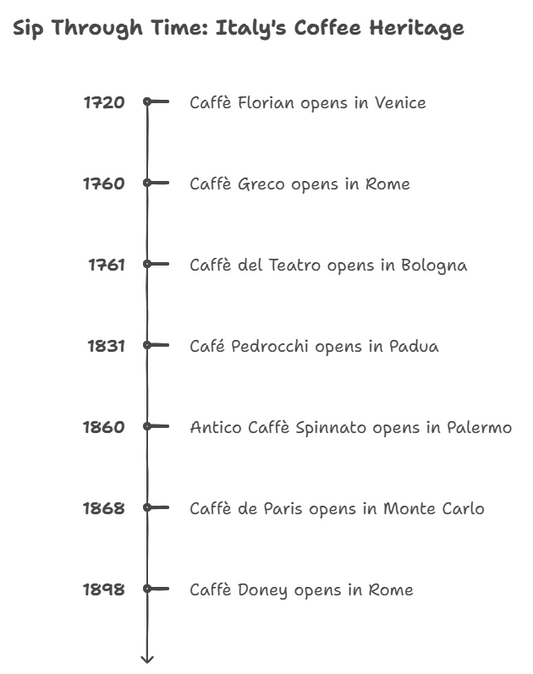The earliest possible evidence of Italian pasta dates to the Etruscan civilization. A 400 BCE Etruscan tomb in Tuscany containing objects that some historians believe to be tools and kitchen utensils used to roll and form pasta very similar to those still in use today.

A Torchio – one of the first pasta machine: https://www.italytravelandlife.com/food/food-icons-italy/
Marco Polo
Marco Polo arrived in China in 1274. In the 17 years that Marco Polo spent in China, dining with the likes of Kublai Khan, he certainly sampled the various forms of Asian pasta.

Image of Marco Polo http://www.silk-road.com/artl/marcopolo.shtml

Outline of Marco Polo’s travel to Asia countries:
https://scholarblogs.emory.edu/noodles/2018/07/08/tracing-the-origins-of-the-noodle/
According to one edition of Marco Polo's "Description of the World," which the Venetian merchant wrote after returning home from the East, he ate dishes similar to macaroni during his stint.
From that brief mention, a legend arose that the famed explorer must've introduced pasta to Italy. However, this is just a myth.
Asian Pasta
Asian Pasta (also referred to as noodles) was discovered among relics at the Lajia archeological site in Minhe County, Qinghai Province.
In 2002, an archaeological team led by Ye Maolin, a researcher with the Institute of Archaeology of China Academy of Social Sciences (CASS), discovered noodles at the excavation site, estimated to be over 4,000 years old.
The noodles were found in a red pottery bowl at the site, a large scale settlement of the Neolithic Age in Lajia Village, Guanting Town, Minhe Hui, and Tu Autonomous County, Haidong City of northwest China’s Qinghai Province.

The noodle found on the floor of the site which was once a house, about 2 meters below ground.
In 2004, Professor Lu took parts of the remains of the noodles analysis and found the noodle was made of foxtail and broomcorn millet.

Foxtail Millet: https://www.indiamart.com/proddetail/foxtail-millet-16171366988.html

Broomcorn millet: https://www.made-in-china.com/showroom/wjiaping/product-detailYMKxjHIvHGkm/China-Broomcorn-Millet.html
Real Origin of Pasta
When tracing the origins of Italian pasta, historians look to a plant, rather than an individual. The cultivation of durum wheat offers more clues to how Italian pasta evolved into the country's trademark food.
Durum wheat has high levels of gluten which adds malleability to pasta dough. Chinese climate isn’t conducive to durum wheat production whereas this cereal thrives in Italy’s environment.

Durum wheat grows naturally in Italy: https://recipes.howstuffworks.com/marco-polo-pasta.htm
Pasta over the years
From the 13th century, references to pasta dishes—macaroni, ravioli, gnocchi, vermicelli—crop up with increasing frequency across the Italian Peninsula.

Macaroni: https://www.123rf.com/photo_85692647_a-very-close-view-of-small-yellow-elbow-macaroni.html

Ravioli: https://www.123rf.com/photo_25709835_ravioli-pasta-squares

Gnocchi: https://www.jocooks.com/recipes/gnocchi-recipe/

Vermicelli: https://www.the-pasta-project.com/vermicelli/

14th century – women making pasta: https://en.wikipedia.org/wiki/Pasta
In the 14th and 15th centuries, dried pasta became popular for its easy storage. This allowed people to store pasta on ships when exploring the New World. A century later, pasta was present around the globe during the voyages of discovery.
Throughout the Middle Ages which started from 13th, until the start of the 16th century, pasta dishes were markedly different from those eaten today.
Not only was pasta cooked for longer, but there was also none of the modern-day preference for pasta al dente, which means firm to the bite. Pasta in the olden times was also mixed with ingredients that would seem surprising now, often combining sweet, savory, and spicy flavors.
Pasta in the 16th century was considered a dish for the wealthy, taking pride of place in aristocratic banquets during the Renaissance. (14th to 17th Century).
By the late 17th century in Naples, it was becoming the main staple of the common diet. Neapolitans had been nicknamed leaf-eaters in the 1500s. However, from the 1700s they started to be called macaroni-eaters instead. They are the 17th-century native of the city where cheap wheat and rising meat prices were turning pasta into an affordable staple.

Painting of ‘Macaroni Eaters’ by Domenico Gargiulo: https://www.meisterdrucke.uk/fine-art-prints/Domenico-Gargiulo/638776/Macaroni-Eaters.html
The above painting shows Three Neapolitan beggars eating a dish of macaroni with their hands in the middle of a street.

https://italicsmag.com/2020/05/29/a-brief-history-of-pasta/
By the late 17th century in Naples was becoming the European hub of pasta production and consumption. The deterioration in the common people’s standard of living had significantly limited their access to meat, while the large landowners in the Kingdom of Naples or Sicily sold wheat relatively cheaply.
Religious restrictions also influenced the changing diet: Pasta was an ideal food for days when eating meat was forbidden. The main reason for pasta’s dramatic spread was that, from the 17th century, industrial pasta production was developed with the use of machines such as the Torchio, a mechanical press to make noodles or vermicelli.
The Pasta Factory
Paul-Jacques Malouin was a French scientist who brought the trade of vermicilier to Paris. He also brought the industrial production techniques he had seen in Naples to the French capital, including the kneading machine and screw press, whose workings he demonstrates in an engraving from a book he published in 1767.

Portrait of Paul-Jacques Malouin : https://prabook.com/web/paul-jacques.malouin/375759

Photo of Pasta machine: https://www.nationalgeographic.com/history/magazine/2016/07-08/daily-life-pasta-italy-neapolitan-diet/
The Kneading Machine
An operator sitting on a bar (A) moves up and down to knead the pasta (B). The process took two hours to complete.
The Press
The kneaded pasta is placed in a cylinder that is compressed by a screw (C). The press is turned using a system of levers and ropes moved by an operator (D). The strands of noodles emerge beneath (E).
Modern Pasta
Several things that have changed drastically over time are the flavorings added to pasta. Sweetness has been replaced by savory, sugar swapped out for vegetables, which helped make pasta a nutritionally complete dish.
Then, at the beginning of the 19th century, tomatoes were added. For a long time, Italians considered them to be too exotic. It is not until 1844 that the first recipe appears for the most common pasta dish today: spaghetti in tomato sauce.

https://www.taste.com.au/recipes/pasta-simple-tomato-sauce/2e1c4bdd-b318-4396-94db-a6fe2047167a
The art of pasta making and the devotion to the food as a whole has evolved since pasta was first conceptualized. It is estimated that Italians eat over 27 kg of pasta per person, per year, easily beating Americans, who eat about 9 kg per person.
Pasta is so beloved in Italy that individual consumption exceeds the average production of wheat of the country; thus Italy frequently imports wheat for pasta making which is largely mass-produced in factories and only a tiny proportion is crafted by hand.
It was originally solely a part of Italian and European cuisine. With an increase in popularity on a worldwide scale, pasta has crossed international borders and is now a popular form of fast food and a staple in North America and elsewhere due to the great amount of Italian immigration into Canada and the United States around the beginning of the 20th century.
Pasta is the Italian designation or name given to a type of starchy noodle or dumpling food or dish typically made from grain flour, commonly wheat, mixed into a paste or dough, usually with water or eggs, and formed or cut into sheets or other shapes.
It is usually cooked by boiling, baking, or frying. Rice flour, or legumes such as beans or lentils, are sometimes used in place of wheat flour to yield a different flavor and texture, or as a gluten-free alternative. Pasta is a staple food ingredient of Italian cuisine.

Collection of different pasta varieties: https://en.m.wikipedia.org/wiki/Pasta
Sources




